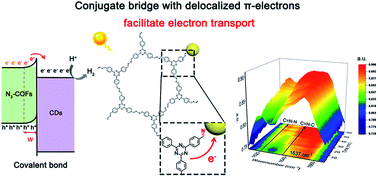Constructing a conjugated bridge for efficient electron transport at the interface of an inorganic–organic hetero-junction†
Abstract
The large barrier between the phase interfaces of heterojunction catalysts inhibits the electron transfer, resulting in a limited catalytic efficiency. Herein, amino-grafted carbon dots (CDs) were utilized as the building units for the preparation of a CD covalently doped porous polymer. Due to the formation of a conjugated bridge (C![[double bond, length as m-dash]](https://www.rsc.org/images/entities/char_e001.gif) N bond) with delocalized π-electrons, photo-generated electrons were quickly transferred from an organic semiconductor (N3-COF) to an inorganic semiconductor (CDs). Correspondingly, the improvement percentage for the H2 production rate of CD-N3-COF was 560% and 290% compared to that of the physically doped and single bond linked COF systems, respectively. This work provides significant inspiration for consciously regulating the bridge structure at the atomic-level to facilitate the electron transport for the preparation of high-performance heterojunction catalysts.
N bond) with delocalized π-electrons, photo-generated electrons were quickly transferred from an organic semiconductor (N3-COF) to an inorganic semiconductor (CDs). Correspondingly, the improvement percentage for the H2 production rate of CD-N3-COF was 560% and 290% compared to that of the physically doped and single bond linked COF systems, respectively. This work provides significant inspiration for consciously regulating the bridge structure at the atomic-level to facilitate the electron transport for the preparation of high-performance heterojunction catalysts.

- This article is part of the themed collection: Journal of Materials Chemistry A Emerging Investigators


 Please wait while we load your content...
Please wait while we load your content...